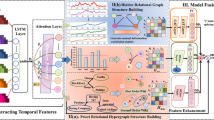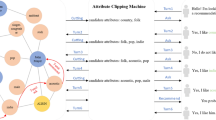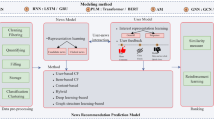Abstract
The recommendation system based on the knowledge graph usually introduces attribute information as supplements to improve the accuracy. However, most existing methods usually treat the influence of attribute information as consistent. To alleviate this problem, we propose a personalized recommendation model based on the attribute significance of the knowledge graph attention network (AS-KGAN). Firstly, to obtain user preferences on the knowledge graph and maintain the inherent structure and semantic information, we consider the entity types in the knowledge graph and conduct modeling in an end-to-end approach. Secondly, when introducing item attribute information, we consider the significance of different attributes on items and use the graph attention network to distinguish them. Thirdly, to obtain deeper representations of user preferences, the weights of node neighborhoods are learned during propagation. Finally, to better obtain the high-order relationships and ensure interpretability, we model the high-order connectivity explicitly in the knowledge graph. The model generates top-K recommendations for target users by predicting the probability that users will interact with the item. We applied this model to three public datasets, and the experimental results indicate that the recommendation quality of our model has improved compared with other models.





Similar content being viewed by others
References
Cheng L, Gao MT (2019) Hybrid recommendation algorithm based on time weighted and LDA clustering [J]. Computer Eng Appl 55(11):160–166
Jamali M, Ester M (2010) A matrix factorization technique with trust propagation for recommendation in social networks. Proceedings of the Fourth ACM Conference on Recommender Systems, 135–142. https://doi.org/10.1145/1864708.1864736
Wang HW, Zhang FZ, Hou M et al (2018) Shine: Signed heterogeneous information network embedding for sentiment link prediction. Proceedings of the Eleventh ACM International Conference on Web Search and Data Mining, 592–600. https://doi.org/10.1145/3159652.3159666
Bansal T, Belanger D, Mccallum A (2016) Ask the GRU: Multi-Task Learning for Deep Text Recommendations. Proceedings of the 10th ACM Conference on Recommender Systems, 107-114. https://doi.org/10.1145/2959100.2959180
Sharma A, Cosley D (2013) Do social explanations work? Studying and modeling the effects of social explanations in recommender systems. Proceedings of the 22nd international conference on World Wide Web, 1133-1144. https://doi.org/10.1145/2488388.2488487
Chang L, Zhang WT, Gu TL et al (2019) Review of recommendation systems based on knowledge graph. CAAI Trans Intell Syst 14(2):207–216. https://doi.org/10.11992/tis.201805001
Yu X, Ren X, Sun YZ, et al. (2014) Personalized entity recommendation: A heterogeneous information network approach. Proceedings of the 7th ACM International Conference on Web Search and Data Mining, 283-292. https://doi.org/10.1145/2556195.2556259
Hu BB, Shi C, Zhao WX, et al. (2018) Leveraging meta-path based context for top-n recommendation with a neural co-attention model. Proceedings of the 24th ACM SIGKDD International Conference on Knowledge Discovery And Data Mining, 1531-1540. https://doi.org/10.1145/3219819.3219965
Zhao H, Yao QM, Li JD, et al. (2017) Meta-graph based recommendation fusion over heterogeneous information networks. Proceedings of the 23rd ACM SIGKDD International Conference on Knowledge Discovery and Data Mining, 635-644. https://doi.org/10.1145/3097983.3098063
Wang X, Wang DX, Xu CR et al (2019) Explainable reasoning over knowledge graphs for recommendation. Proceedings of the AAAI Conference on Artificial Intelligence. 33(01):5329–5336. https://doi.org/10.1609/aaai.v33i01.33015329
Wang X, Huang TL, Wang DX et al (2021) Learning Intents behind Interactions with Knowledge Graph for Recommendation. Proceedings of the Web Conference. 878–887. https://doi.org/10.1145/3442381.3450133
Wang Q, Mao Z, Wang B et al (2017) Knowledge graph embedding: a survey of approaches and applications. IEEE Trans Knowl Data Eng 29(12):2724–2743. https://doi.org/10.1109/TKDE.2017.2754499
Zhang FZ, Yuan NJ, Lian D, et al (2016) Collaborative knowledge base embedding for recommender systems. Proceedings of the 22nd ACM SIGKDD International Conference on Knowledge Discovery and Data Mining, 353-362. https://doi.org/10.1145/2939672.2939673
Wang HW, Zhang FZ, Xie X, et al (2018) DKN: Deep knowledge-aware network for news recommendation. Proceedings of the 2018 World Wide Web Conference, 1835-1844. https://doi.org/10.1145/3178876.3186175
Nathani D, Chauhan J, Sharma C, et al (2019) Learning attention-based embeddings for relation prediction in knowledge graphs. Proceedings of the 57th Annual Meeting of the Association for Computational Linguistics. https://doi.org/10.18653/v1/P19-1466
Zhao XX, Cheng ZY, Zhu L, et al. (2021) UGRec: Modeling directed and undirected relations for recommendation. Proceedings of the 44th International ACM SIGIR Conference on Research and Development in Information Retrieval, 193-202. https://doi.org/10.1145/3404835.3462835
Wang HW, Zhang FZ, Wang JL, et al. (2018) RippleNet: Propagating user preferences on the knowledge graph for recommender systems. Proceedings of the 27th ACM International Conference on Information and Knowledge Management, 417-426. https://doi.org/10.1145/3269206.3271739
Wang Z, Lin GY, Tan HB, et al. (2020) CKAN: Collaborative knowledge-aware attentive network for recommender systems. Proceedings of the 43rd International ACM SIGIR Conference on Research and Development in Information Retrieval, 219-228. https://doi.org/10.1145/3397271.3401141
Hamilton WL, Ying R, Leskovec J (2017) Inductive representation learning on large graphs. Proceedings of the 31st International Conference on Neural Information Processing Systems, 1025-1035
Wang J (2019) Graph neural network analysis. Modern Computer 23:58–62
Berg R, Kipf TN, Welling M (2018) Graph convolutional matrix completion. Proceedings of KDD’18 Deep Learning Day, August 2018, London, UK. https://doi.org/10.48550/arXiv.1706.02263
Wang HW, Zhao M, Xie X et al (2019) Knowledge graph convolutional networks for recommender systems. Proceedings of World Wide Web Conference, New York: ACM Press, 3307–3313. https://doi.org/10.1145/3308558.3313417
Li X, Yang XY, Yu J et al (2022) Double end knowledge graph convolutional networks for recommender systems. J Front Computer Sci Technol 16(1):176. https://doi.org/10.3778/j.issn.1673-9418.2103072
Ji GL, He SZ, Xu LH, et al. (2015) Knowledge graph embedding via dynamic mapping matrix. Proceedings of the 53rd Annual Meeting of the Association for Computational Linguistics and the 7th International Joint Conference on Natural Language Processing (Volume 1: Long Papers), 687-696
Kipf TN, Welling M (2017) Semi-supervised classification with graph convolutional networks. International Conference on Learning Representations (ICLR), 2017. https://doi.org/10.48550/arXiv.1609.02907
Maas AL, Hannun AY, Ng AY (2013) Rectifier nonlinearities improve neural network acoustic models. In ICML, Vol. 30. 3
Veličković P, Cucurull G, Casanova A, et al. (2018) Graph attention networks. In Proceedings of the 6th International Conferences on Learning Representations, 2018. https://doi.org/10.48550/arXiv.1710.10903
Xu K, Li C, Tian Y, et al. (2018) Representation learning on graphs with jumping knowledge networks. International Conference on Machine Learning. PMLR, 5453-5462
Rendle S, Freudenthaler C, Gantner Z, et al. (2009) BPR: Bayesian personalized ranking from implicit feedback. In UAI. 452-461. https://doi.org/10.48550/arXiv.1205.2618
He R, McAuley J (2016) Ups and downs: Modeling the visual evolution of fashion trends with one-class collaborative filtering. Proceedings of the 25th International Conference on World Wide Web, 507-517. https://doi.org/10.1145/2872427.2883037
Bizer C, Lehmann J, Kobilarov G et al (2009) DBpedia: a crystallization point for the web of data. Web Seman Sci Serv Agents on the World Wide Web 7(3):154–165. https://doi.org/10.1016/j.websem.2009.07.002
He XN, Liao LZ, Zhang HW, et al. (2017) Neural collaborative filtering. Proceedings of the 26th International Conference on World Wide Web, 173-182. https://doi.org/10.1145/3038912.3052569
Yang JH, Chen CM, Wang CJ, et al. (2018) HOP-rec: high-order proximity for implicit recommendation. Proceedings of the 12th ACM Conference on Recommender Systems, 140-144. https://doi.org/10.1145/3240323.3240381
Acknowledgements
The authors are grateful to the editors and reviewers for their helpful comments and suggestions. This research is partially supported by National Social Science Foundation project (17BXW065), National Key R &D Program of China (2018******01).
Author information
Authors and Affiliations
Corresponding author
Additional information
Publisher's Note
Springer Nature remains neutral with regard to jurisdictional claims in published maps and institutional affiliations.
Rights and permissions
Springer Nature or its licensor (e.g. a society or other partner) holds exclusive rights to this article under a publishing agreement with the author(s) or other rightsholder(s); author self-archiving of the accepted manuscript version of this article is solely governed by the terms of such publishing agreement and applicable law.
About this article
Cite this article
Wang, C., Zhang, H., Li, L. et al. Knowledge Graph Attention Network with Attribute Significance for Personalized Recommendation. Neural Process Lett 55, 5013–5029 (2023). https://doi.org/10.1007/s11063-022-11077-0
Accepted:
Published:
Issue Date:
DOI: https://doi.org/10.1007/s11063-022-11077-0




